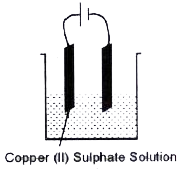Copper sulphate soln. is electtrolysed using copper electrodes as seen in diagram .
Which electrode to your left or right is known as the oxidising electrode & why ?

Step by step video & image solution for Copper sulphate soln. is electtrolysed using copper electrodes as seen in diagram . Which electrode to your left or right is known as the oxidising electrode & why ? by Chemistry experts to help you in doubts & scoring excellent marks in Class 10 exams.
Updated on:21/07/2023Similar Questions
Copper sulphate soln. is electtrolysed using copper electrodes as seen in diagram .
State two appropriate observations for the above electrolysis reaction

View SolutionCopper sulphate solution is electrolysed using copper electrodes. Study the diagram given below and answer the question that follows: Which electrode to your left or right is known as the oxidising electrode and why?

View Solution
Knowledge Check
Study the given figure and answer the question that follow:

Which electrode is the oxidising electrode?AABBCBoth (a) and (b)DNone of these
Which electrode : anode or cathode is the oxidising electrode ? Why?
View SolutionWhich electrode : anode or cathode is the oxidising electrode ? Why?
View SolutionCopper sulphate solution is electrolysed using copper electrodes. Study the diagram given below and answer the question that follows:

Write the equation representing the reaction that occurs.
View SolutionCopper sulphate solution is electrolysed using copper electrodes. Study the diagram given below and answer the question that follows:

State two appropriate observations for the above electrolysis reaction.
View SolutionA solution of copper (II) sulphate is electrolysed between copper electrodes by a current of 10.0 amperes passing for one hour. What changes occur at the electrodes and in the solution?
View SolutionA solution of sodium sulphate was electrolyzed using some inert electrode. The product at the electrodes are
View SolutionStudy the diagram given below and answer the question that follow

Which electrons is the oxidising electrode ?
View Solution
